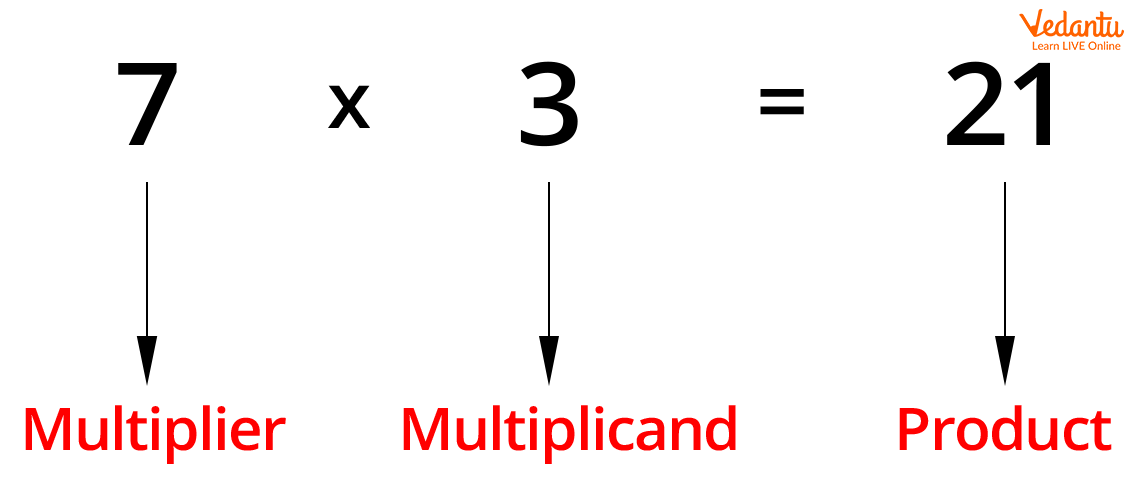




How to Identify Multiplier and Multiplicand in Multiplication Problems
There are four basic operations of Mathematics – these are addition, subtraction, multiplication, and division. So, multiplication is one of the elementary operations of computation in Mathematics. In the process of multiplication, the number to be multiplied is termed the multiplicand and the number with which we multiply is called the multiplier. Product is the result of multiplication. In the below given example, the multiplication of 8 and 5 is performed where 8 is the multiplier, 5 is multiplicand, and 40 is the product. There is a ‘’ sign that is used to represent multiplication.

Image: Example of multiplication
Properties of Multiplication
There are some properties of multiplication which are as follows:
Commutative Property of Multiplication
According to the commutative property of multiplication, when the order of the multiplier and multiplicand are changed, the product does not change.
For example: 4 × 3 = 12 or 3 × 4 = 12
So, 4 × 3 = 3 × 4.
Associative Property of Multiplication
According to the associative property of multiplication, the product of three or more numbers does not change if we change the grouping of the numbers.
For example: (4 × 7) × 5 = 28 × 5 = 140
or, (7 × 5) × 4 = 35 × 4= 140
or, (4 × 5) × 7 = 20 × 7 = 140
One Property of Multiplication
According to one property of the multiplication, the product of a number and 1 is the number itself.
For example:
18 × 1 = 18
75 × 1 = 75
54 × 1 = 54
21 × 1 = 21
Zero Property of Multiplication
According to the zero property of multiplication, the result of multiplication of any number and zero is zero.
For example:
5 × 0 = 0
0 × 15 = 0
24 × 0 = 0
90 × 0 = 0
Distributive Property of Multiplication
According to the distributive property of multiplication, the product of a number and the sum of two numbers is always the same as the sum of the product of the numbers.
For example:
4 × (3 + 5) = 4 × 8 = 32
4 × 3 + 4 × 5 = 32
So, 4 × (3 + 5) = 4 × 3 + 4 × 5 = 32
In the same way, the product of a number and the difference of two numbers is also always the same as the difference of the product of the numbers.
For example:
4 × (6 − 5) = 4
4 × 6 − 4 × 5 = 24 − 20 = 4
So, 4 × (6 − 5) = 4 × 6 − 4 × 5 = 4
Conclusion
It is important for the students to clearly understand the concept of multiplier and multiplicand. The properties of multiplication are based on multiplier and multiplicand. Every property of multiplication is explained with examples in the above article.
FAQs on Multiplier and Multiplicand Explained with Easy Examples
1. What are the three main parts of a multiplication problem?
A multiplication problem has three main parts: the multiplicand (the number being multiplied), the multiplier (the number you multiply by), and the product (the final answer). For example, in 5 x 3 = 15, the number 5 is the multiplicand, 3 is the multiplier, and 15 is the product.
2. How is multiplication related to repeated addition?
Multiplication is essentially a shortcut for repeated addition. For instance, multiplying 4 x 3 is the same as adding the number 4 three times (4 + 4 + 4). In both cases, the answer is 12. This shows that the multiplier tells you how many times to add the multiplicand.
3. What are the most important properties of multiplication for young students?
For students just starting with multiplication, the key properties to understand are:
- Commutative Property: This means changing the order of the numbers does not change the final answer. For example, 5 x 2 is the same as 2 x 5.
- Identity Property: Any number multiplied by 1 is always the number itself. For example, 7 x 1 = 7.
- Zero Property: Any number multiplied by 0 is always 0. For example, 9 x 0 = 0.
4. Does the result change if we swap the multiplier and the multiplicand?
No, the final answer, or the product, does not change. This is a fundamental rule of multiplication called the Commutative Property. For example, multiplying 6 by 4 (6 x 4) gives you 24, which is the exact same result as multiplying 4 by 6 (4 x 6).
5. How does understanding the multiplier and multiplicand help in solving word problems?
Understanding these terms helps you visualise what a word problem is asking. Typically, the multiplicand represents the size of a group (like '8 crayons per box'), while the multiplier represents the number of groups (like '4 boxes'). This helps you correctly set up the multiplication problem (8 x 4) to find the total number of crayons.
6. Can you explain the role of the 'product' in a multiplication sentence?
The product is the total amount you get after performing the multiplication. It is the final answer. In the equation 8 x 2 = 16, the number 16 is the product. It represents the total value when you combine 2 groups of 8, or 8 groups of 2.























